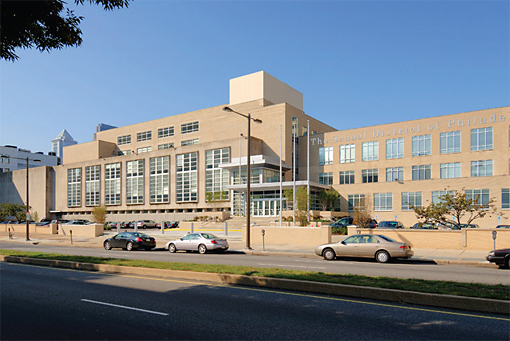| 제목 | [DAIKIN] K-12 EDUCATION - Philadelphia School Administration | 작성일 | 16-06-16 12:00 |
| 글쓴이 | 최고관리자 | 조회수 | 3,927 |
본문
CASE STUDY
K-12 Education
Name
School District of Philadelphia Education Center
Location
Philadelphia, PA USA
Facility Size
5 floors, 848,000 ft2 facility
Issue
Controlling renovation first costs and operating costs—particularly maintenance costs
Solution
17 self-contained air conditioning systems with electric heaters
Philadelphia Education Center gets high marks for low first cost and operating cost
Daikin self-contained air-conditioning units help meet renovation requirements
Carved out of a 1948 printing facility, the new School District of Philadelphia Education Center has become a cornerstone of the revitalized North Broad Street corridor. Its imposing size—totaling 848,000 square feet on five floors—allows the district to house all of its 1500 administrative employees under one roof for the first time, while creating community spaces inviting to employees and visitors. Amenities include 13 conference rooms, a parent and community relations office, space for parent workshops and a multicultural research library. The building's main architectural feature—a three-story central atrium—creates a large and airy public space where students from district schools display artwork and perform at special events.
Due to the size of the renovation project and the public dollars involved, controlling first cost and operating costs—particularly maintenance costs—were primary goals. Factor in the building's reinforced concrete floors, and the project posed a challenge for introducing a new HVAC system without incurring significant reconstruction costs. To meet these requirements, engineers specified the installation of 17 self-contained air conditioning systems with electric heaters to condition the space. Daikin self-contained units were chosen, primarily for their ability to handle the high static pressures of the application.
Meeting low first cost goals
School District officials set low first cost as a primary goal for the project, and it was strictly adhered to, according to the Philadelphia Inquirer. "Even Ben Franklin might be shocked by the degree of thrift that governed the district's renovation of the sprawling industrial building," wrote reporter Inga Saffron in an article published October 2, 2005. The Daikin self-contained units helped meet that requirement.
"Self-contained units are more cost-effective to install than a central chiller plant," said Mike Rush, lead engineer, Cannon Design, New York City. In fact, according to Daikin, self-contained units can lower installed cost by $1.00 to $2.50 per square foot over chilled water systems. That's because they eliminate the need for large chiller equipment rooms and the additional pumps and chilled water piping that a central system requires.
Specific features of the Daikin self-contained systems also contribute to the indoor air quality of the facility and to a quieter environment: Double-wall panel construction reduces the possibility of fibers in the supply air system. Double-sloped, stainless steel drain pans eliminate stagnant water and the potential for bacterial growth. A supply air plenum with thick, high-density insulation and lined with perforated metal reduces noise levels in the air stream. Welded construction helps minimize vibration.
Handling high static pressures
According to Rush, a primary reason for choosing Daikin self-contained systems over competitors was their ability to handle the high static pressures of the application. "I was confident that the Daikin units could provide adequate air supply for each space," said Rush. "The floor plates in the building are large—each floor is about 160,000 square feet—and each unit serves about 40,000 square feet. We had to assure that we had enough static pressure in the fans to supply air all the way to the far corners of the building."
The Daikin units, equipped with high-efficiency, airfoil fans, provide the static pressure required, while the factory-mounted acoustical discharge plenums help reduce turbulence and fan noise. By offering more choices in fan styles, cabinet sizes and compressors than most manufacturers, Daikin can provide self-contained units that more precisely meet the design requirements of each application.
Meeting goals for maximum natural light
Besides controlling first cost, another goal of the renovation was to bring in as much natural light as possible—creating an inviting, comfortable space to work and visit. The three-story central atrium supplies natural light to the interior spaces through overhead skylights, while large banks of windows along the outer walls of the building provide light to individual offices.
Engineers specified waterside economizers for the self-contained units partly to maximize this available light. The use of airside economizers would have required the installation of large intake and relief louvers on the exterior of the building, which would mean using available window space. "Self-contained units equipped with waterside economizers can also be centrally located on each floor, which is another advantage," noted Rush.
Meeting low operating cost goals
"Waterside economizers effectively use low water temperatures in the cooling tower to offload compressor operation and thus help to save on operating costs," said Rush. Cooling tower water is pumped through a secondary economizer coil, located upstream from the evaporator coil in the self-contained unit. Control valves modulate the water flow to the economizer coil to satisfy the cooling demand whenever the entering water temperature is suitable (less than 50°F). When the outside temperature rises and the condenser water temperature is not suitable to accommodate all of the cooling demand, the MicroTech II controller will adjust the control valves to supply water to the waterside economizer and condenser coil using a mix of free-cooling and mechanical cooling to meet cooling demand. This feature saves energy by supplementing the mechanical cooling with "free-cooling". When the entering water temperature is no longer suitable for "free-cooling" the economizer valves close and the unit transitions to mechanical cooling.
Outdoor air for the self-contained units is provided through a pressurized ducted shaft to the mechanical room, where it is mixed with return air from the space. Each self-contained unit also includes electric heating coils. Additional heat for the foyer, main floor restrooms, mechanical rooms and other areas is provided by electric cabinet heaters.
Although an electric heating system can be more costly to operate than a steam or water system, district officials wanted to keep maintenance costs as low as possible. "It was important to provide a reliable system that would require minimal service," said Rush. One of the disadvantages of a steam or hot water system is that it would require maintenance staff to maintain valves and others parts of the system during off-business hours or premium times when labor costs are higher. Electric systems also require much less regular maintenance.
To simplify maintenance, the Daikin units are designed so that all major components—including the condensers, compressor, and expansion valves—are located out of the supply air stream. This makes it possible to perform measurements and adjustments while the unit is operating. Removable panels make it easy to access components within the units.
Given its age and size, the 60-year-old printing facility could well have remained a relic of the past or been torn down. Instead, Philadelphia School District officials recognized the advantages of consolidating their various locations and created a new landmark. By setting specific goals for the project, they were able to develop a facility with a cost-effective HVAC system that is easy to maintain and helps contribute to a healthy and comfortable place to work and learn.

Daikin self-contained units can lower installed cost by $1.00 to $2.50 per square foot over chilled water systems. That's because they eliminate the need for large chiller equipment rooms and the additional pumps and chilled water piping that a central system requires.
| 이전글 | [DAIKIN] K-12 EDUCATION - Northbrook Jr High 2016-06-16 | ||
| 다음글 | [DAIKIN] MANUFACTURING - Hydro Quebec Utility Camoplast 2016-06-16 | ||






